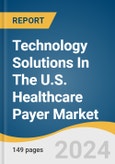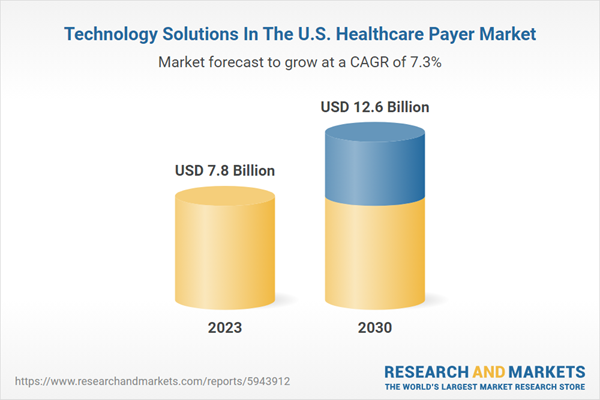The technology solutions in the U.S. healthcare payer market size is anticipated to reach USD 12.6 billion by 2030. The market is expected to expand at a notable CAGR of 7.3% from 2024 to 2030. Major factors driving the market growth include enrollment and billing modernization, growing acquisition by market leaders, growing interest of investors and venture capitalists, and revolutionizing healthcare using innovative technologies.
The interest of investors and venture capitalists in the healthcare payer sector is growing as technology startups focusing on this industry draw substantial attention. This increased attention is driven by several factors, such as digital transformation, value-based care, telehealth, data analytics, and consumer-centric care, highlighting the significant potential for innovation and expansion in the healthcare payer domain. The healthcare industry is undergoing rapid transformation, driven by evolving patient expectations, the shift toward value-based care, and the increasing demand for more accessible & personalized healthcare experiences. These changes have created a competitive environment for startups to introduce innovative technologies and solutions, with the potential to improve and enhance various aspects of the healthcare payer ecosystem.
The initial phase of the pandemic required a strong emphasis on ensuring business continuity, member communication, and support, and these priorities remained important for the future. As the pandemic progressed from a remote concern to a global crisis, marked by extensive closure of schools and businesses for social distancing, payers found engaging with diverse stakeholders to manage the response measures collectively imperative. Healthcare payers adopted several response measures, such as establishing collaborative forums with providers and government response teams, proactive identification of high-risk members, and preparation for supply and demand imbalances.
Moreover, key players in the market are engaging in strategic initiatives such as partnerships, collaborations, new product launches, acquisitions, and expansions to strengthen their market position and expand their customer base. For instance, in March 2023, Pegasystems Inc. announced enhancements to the Pega Foundation for Healthcare. The platform will include intelligent AI-powered decision-making, personalized & responsive benefits, and expanded interoperability to help payers, care providers, & customers. Moreover, in April 2023, Cognizant and Microsoft announced an expansion of their long-standing healthcare collaboration to provide healthcare providers and payers with access to streamlined claims management, advanced technology solutions, and improved interoperability to provide better patient and member experiences and optimize business operations. Microsoft and Cognizant are expected to work collaboratively to develop an integration roadmap between Cognizant's TriZetto healthcare technologies and Microsoft Cloud for Healthcare.
The interest of investors and venture capitalists in the healthcare payer sector is growing as technology startups focusing on this industry draw substantial attention. This increased attention is driven by several factors, such as digital transformation, value-based care, telehealth, data analytics, and consumer-centric care, highlighting the significant potential for innovation and expansion in the healthcare payer domain. The healthcare industry is undergoing rapid transformation, driven by evolving patient expectations, the shift toward value-based care, and the increasing demand for more accessible & personalized healthcare experiences. These changes have created a competitive environment for startups to introduce innovative technologies and solutions, with the potential to improve and enhance various aspects of the healthcare payer ecosystem.
The initial phase of the pandemic required a strong emphasis on ensuring business continuity, member communication, and support, and these priorities remained important for the future. As the pandemic progressed from a remote concern to a global crisis, marked by extensive closure of schools and businesses for social distancing, payers found engaging with diverse stakeholders to manage the response measures collectively imperative. Healthcare payers adopted several response measures, such as establishing collaborative forums with providers and government response teams, proactive identification of high-risk members, and preparation for supply and demand imbalances.
Moreover, key players in the market are engaging in strategic initiatives such as partnerships, collaborations, new product launches, acquisitions, and expansions to strengthen their market position and expand their customer base. For instance, in March 2023, Pegasystems Inc. announced enhancements to the Pega Foundation for Healthcare. The platform will include intelligent AI-powered decision-making, personalized & responsive benefits, and expanded interoperability to help payers, care providers, & customers. Moreover, in April 2023, Cognizant and Microsoft announced an expansion of their long-standing healthcare collaboration to provide healthcare providers and payers with access to streamlined claims management, advanced technology solutions, and improved interoperability to provide better patient and member experiences and optimize business operations. Microsoft and Cognizant are expected to work collaboratively to develop an integration roadmap between Cognizant's TriZetto healthcare technologies and Microsoft Cloud for Healthcare.
Technology Solutions In The U.S. Healthcare Payer Market Report Highlights
- Based on application, the claims management segment held the majority of the market share of 32.2% in the application segment in 2023. As the population of insured individuals and the demand for healthcare services continue to increase, insurance claims are also rising
- Based on solution type, the integrated segment held most of the market share of 64.4% in the solution-type segment in 2023 and is e xpected to witness the fastest growth at a CAGR of 7.5% during the forecast period. The rising emphasis on value-based care & population health management contributes to market growth
- Based on payer type, the commercial segment held the largest market share of 67.1 % in 2023 and is anticipated to witness the fastest growth at a CAGR of 7.5% over the forecast period. The growth is attributed to the increasing adoption of health insurance among the population
Table of Contents
Chapter 1 Methodology And Scope
Chapter 2 Executive Summary
Chapter 3 Technology Solutions In The U.S. Healthcare Payers Market Variables, Trends & Scope
Chapter 5 Technology Solutions In The U.S. Healthcare Payers Market: Application Estimates & Trend Analysis
Chapter 6 Technology Solutions In The U.S. Healthcare Payers Market: Solution Type Estimates & Trend Analysis
Chapter 7 Country Estimates, Technology Solutions In The U.S. Healthcare Payers Market, By Application And Solution Type
Chapter 8 Market Player Analysis
Chapter 9 Technology Solutions In The U.S. Healthcare Payers Market: Competitive Analysis
Chapter 10 Technology Solutions in the U.S. Healthcare Payers Market: Market Player Landscape
List of Tables
List of Figures
Companies Mentioned
- COGNIZANT (TRIZETTO BUSINESS LINE)
- ZEOMEGA
- Oracle
- HealthEdge Software Inc.
- Pegasystems Inc.
- Hyland Software Inc.
- Zyter (Zyter| TrueCare)
- Medecision
- OSP
- Open Text Corporation
- MedHOK, Inc. (MHK)
Methodology

LOADING...
Table Information
| Report Attribute | Details |
|---|---|
| No. of Pages | 149 |
| Published | February 2024 |
| Forecast Period | 2023 - 2030 |
| Estimated Market Value ( USD | $ 7.8 Billion |
| Forecasted Market Value ( USD | $ 12.6 Billion |
| Compound Annual Growth Rate | 7.3% |
| Regions Covered | United States |
| No. of Companies Mentioned | 11 |









